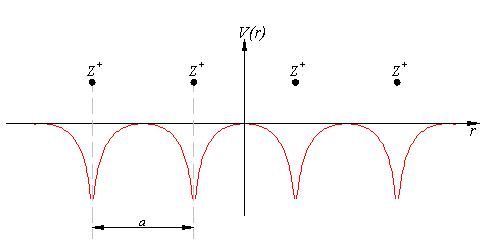In quantum mechanics, the particle in a one-dimensional lattice is a problem that occurs in the model of a periodic crystal lattice. The potential is caused by ions in the periodic structure of the crystal creating an electromagnetic field so electrons are subject to a regular potential inside the lattice. This is an extension of the free electron model that assumes zero potential inside the lattice.
Problem definition
When talking about solid materials, the discussion is mainly around crystals - periodic lattices. Here we will discuss a 1D lattice of positive ions. Assuming the spacing between two ions is a, the potential in the lattice will look something like this:

The mathematical representation of the potential is a periodic function with a period a.
According to Bloch's theorem, the wavefunction solution of the Schrödinger equation when the potential is periodic, can be written as:

Where u(x) is a periodic function which satisfies:

When nearing the edges of the lattice, there are problems with the boundary condition. Therefore, we can represent the ion lattice as a ring following the Born-von Karman boundary conditions. If L is the length of the lattice so that L >> a, then the number of ions in the lattice is so big, that when considering one ion, its surrounding is almost linear, and the wavefunction of the electron is unchanged.
So now, instead of two boundary conditions we get one circular boundary condition:

If N is the number of Ions in the lattice, then we have the relation: aN = L. Replacing in the boundary condition and applying Bloch's theorem will result in a quantization for k:



Kronig–Penney model
The Kronig–Penney model (named after Ralph Kronig and William Penney) is a simple, idealized quantum-mechanical system that consists of an infinite periodic array of rectangular potential barriers.
The potential function is approximated by a rectangular potential:

Using Bloch's theorem, we only need to find a solution for a single period, make sure it is continuous and smooth, and to make sure the function u(x) is also continuous and smooth.
Considering a single period of the potential:
We have two regions here. We will solve for each independently:






To find u(x) in each region, we need to manipulate the electron's wavefunction:


And in the same manner:

To complete the solution we need to make sure the probability function is continuous and smooth, i.e.:

And that u(x) and u'(x) are periodic

These conditions yield the following matrix:

For us not to have the trivial solution, the determinant of the matrix must be 0. This leads us to the following expression:
![{\displaystyle \cos(ka)=\cos(\beta b)\cos[\alpha (a-b)]-{\alpha ^{2}+\beta ^{2} \over 2\alpha \beta }\sin(\beta b)\sin[\alpha (a-b)].\,\!}](https://wikimedia.org/api/rest_v1/media/math/render/svg/0fd5b8332003745abc5435e447fe292d5f93326a)
To further simplify the expression, we perform the following approximations:



The expression will now be:

See also
External links



















![{\displaystyle \cos(ka)=\cos(\beta b)\cos[\alpha (a-b)]-{\alpha ^{2}+\beta ^{2} \over 2\alpha \beta }\sin(\beta b)\sin[\alpha (a-b)].\,\!}](https://wikimedia.org/api/rest_v1/media/math/render/svg/0fd5b8332003745abc5435e447fe292d5f93326a)



